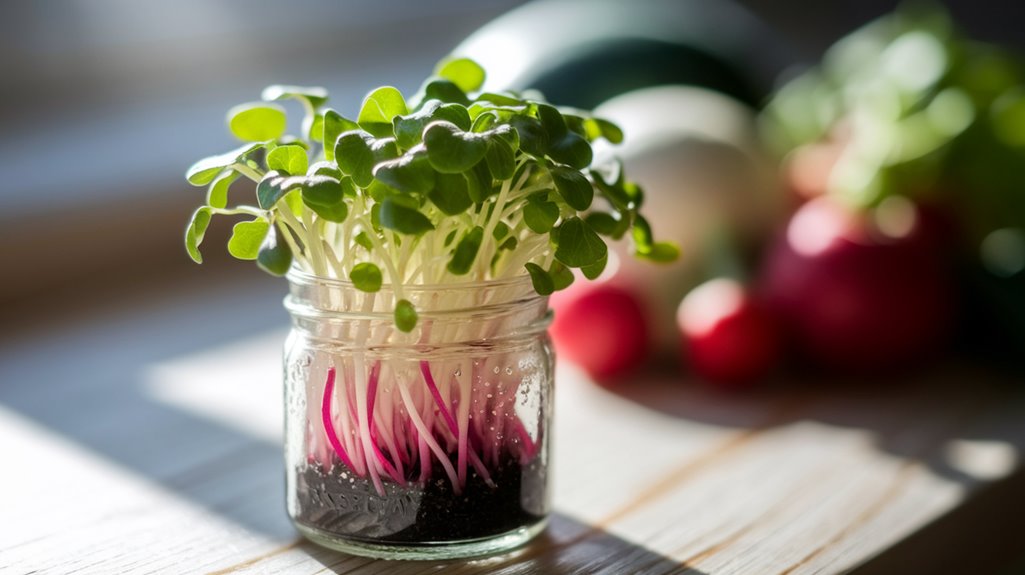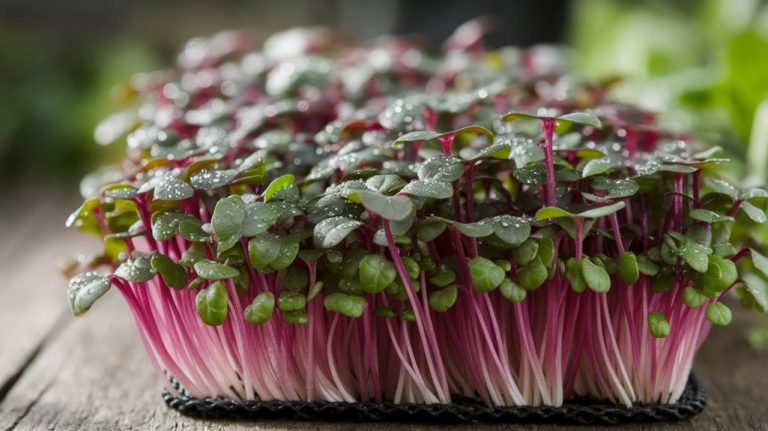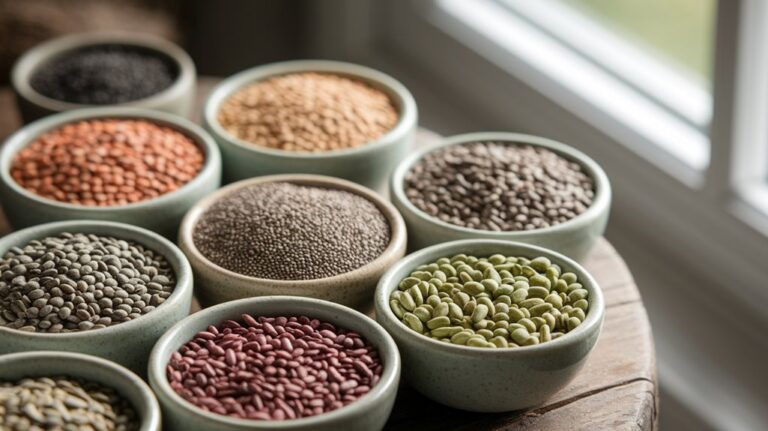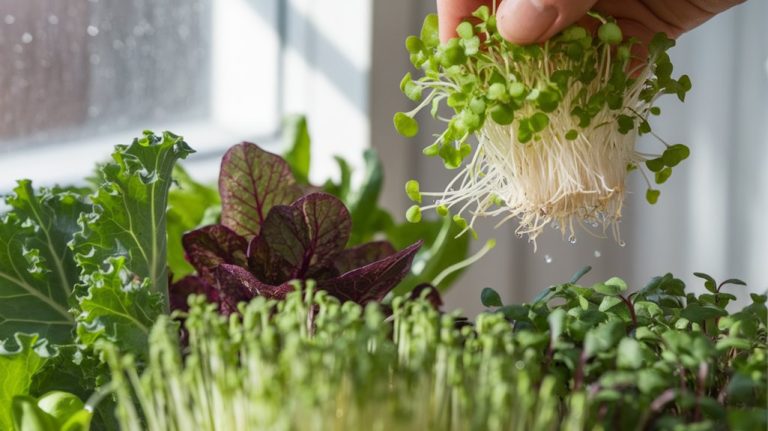How to Grow Radish Sprouting Seeds
To grow radish sprouting seeds, I start by choosing a quick-maturing variety like ‘Cherry Belle.’ Next, I prepare well-draining soil with a pH of 6.0-7.0 and ensure they get at least six hours of sunlight daily. I sow seeds half an inch deep and space them one to two inches apart, keeping the soil consistently moist but not overly wet. By monitoring growth closely, I can ensure healthy plants. There’s more to successful harvesting and enjoying radish greens.
Key Takeaways
- Select a quick-maturing radish variety like ‘Cherry Belle’ for faster sprout growth.
- Sow seeds about half an inch deep and space them one to two inches apart.
- Ensure the soil is well-draining, rich in organic matter, and consistently damp.
- Position seedlings in an area with at least six hours of direct sunlight daily.
- Monitor for pests and diseases, addressing any issues promptly for healthy growth.
Choosing the Right Radish Variety

When selecting a radish variety, I often consider three main factors: growth time, flavor, and climate adaptability.
First, growth time is crucial; some radishes mature in as little as 25 days, while others can take up to 70 days. Quick-maturing varieties, like ‘Cherry Belle,’ are perfect for early planting.
Next, flavor profiles vary significantly. I prefer ‘French Breakfast’ for its mild taste, while ‘Daikon’ offers a spicier kick.
Finally, climate adaptability plays a vital role. Some varieties thrive in cooler temperatures, such as ‘Easter Egg,’ while others can endure heat, like ‘Black Spanish.’
Preparing Your Growing Environment
To ensure a thriving radish crop, I pay close attention to my growing environment, as factors like soil quality, sunlight, and moisture play critical roles.
First, I choose well-draining soil rich in organic matter, aiming for a pH between 6.0 and 7.0. This encourages healthy root development.
Next, I position my radishes in an area that receives at least six hours of direct sunlight daily, as this promotes robust growth.
I also monitor moisture levels, ensuring the soil remains consistently damp but not waterlogged, which can lead to rot.
Additionally, I protect my seeds from extreme temperatures and harsh winds by using row covers if necessary.
With these preparations, I’m setting the stage for a successful radish harvest.
Planting and Caring for Radish Seeds
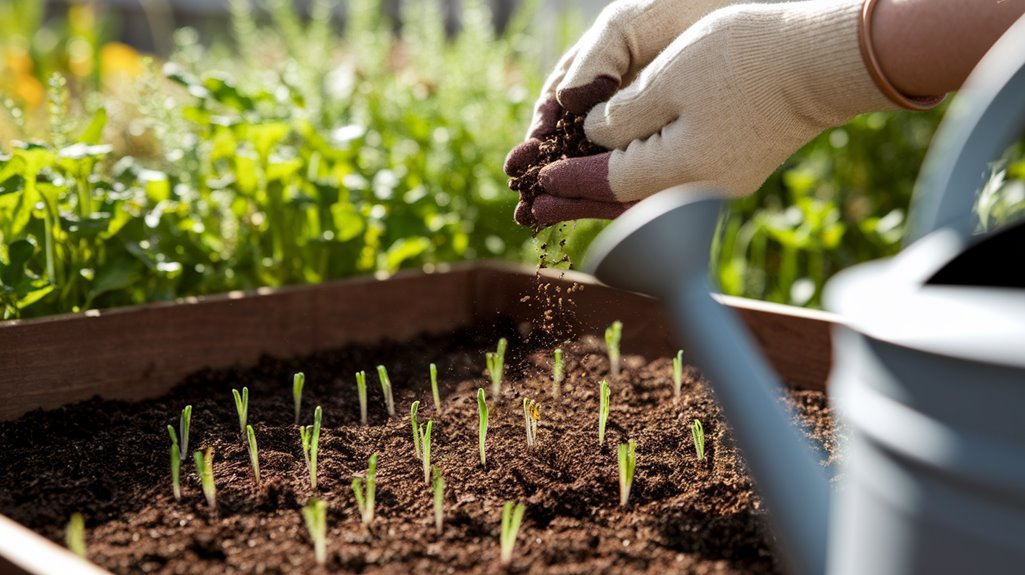
With the growing environment prepared, it’s time to focus on planting and caring for radish seeds.
I recommend sowing seeds about half an inch deep and spacing them one to two inches apart in rows. This spacing allows for proper air circulation and minimizes competition for nutrients.
Water the soil gently after planting but avoid over-saturation, as radish seeds are prone to rot. Keep the soil consistently moist but not soggy.
For optimal growth, I suggest using a balanced fertilizer when seedlings reach about two inches tall.
It’s crucial to monitor for weeds, as they can hinder growth; I hand-pull them to maintain a clean planting area.
With proper care, you’ll set the stage for healthy radish development.
Monitoring Growth and Conditions
As I monitor the growth and conditions of my radish seedlings, I pay close attention to several key factors that influence their development.
First, I check soil moisture regularly, ensuring it remains consistently damp but not waterlogged. Too much moisture can lead to root rot, while too little stunts growth.
Next, I observe the light conditions; radish seedlings thrive in bright, indirect light for at least six hours daily.
Temperature is also crucial; I keep the environment between 60°F and 70°F for optimal growth.
Additionally, I look for any signs of pests or diseases, addressing issues promptly to prevent spread.
Harvesting and Enjoying Your Radish Greens

Once my radish seedlings have reached maturity, it’s time to harvest and enjoy the greens. I carefully check the leaves, aiming for vibrant, healthy greens that are about 4 to 6 inches long.
Using clean scissors, I snip the leaves at the base, ensuring I don’t disturb the roots. It’s important to harvest in the morning when the plants are cooler and more hydrated, which helps preserve their crispness.
After gathering the greens, I rinse them thoroughly under cool water to remove any soil or debris. I gently pat them dry with a clean towel.
I love using radish greens in salads, smoothies, or as a sautéed side dish. Their peppery flavor adds a delightful kick to any meal!
Frequently Asked Questions
Conclusion
In conclusion, growing radish sprouting seeds can be a rewarding experience with just a bit of care and attention. By selecting the right variety, preparing your environment, and monitoring growth, you’ll ensure a successful crop. Remember to harvest your radish greens at the right time for maximum flavor and nutrition. With these steps, you’ll not only enjoy the process but also savor the fresh taste of your homegrown radish greens in your meals.

